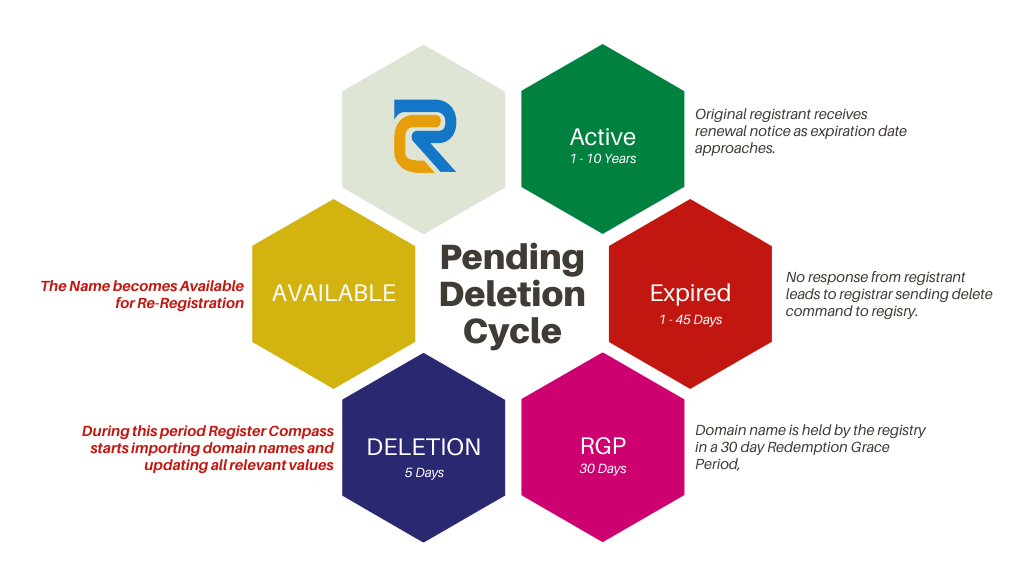Domain Status: Pending Delete – The End of the Cycle
Why do Domains Expire?
Here are some typical reasons why domains expire:
- A domain was registered for a couple of years in advance, but now the credit card has expired, and the domain couldn’t be renewed automatically
- Due to a technical error, the email from the domain registrar with the renewal notification was delivered into a mailbox that is no longer used.
- The renewal notice was delivered but ended up in the junk folder
- The renewal notice was blocked because of spam settings in the email client
- The main company domain has changed and the old domain name was forgotten about
Sometimes companies or people let a domain expire on purpose:
- A business has given up or gone bust
- The owner has no more use for the domain
A Typical Domain Life Cycle (Learn how a Domain Expires)
A domain is registered and active for 1 or more years, after which the domain is not renewed and the expiration process begins.
This period is called “The Grace Period” and can last between 1 and 45 days depending on the TLD, within this grace period the owner is still able to renew the domain on his registrar.
After the grace period the domain goes into the “Redemption Grace Period” (RGP) which lasts for around 30 days, within this period the Whois information of the domain begins to disappear. If the owner decides to renew the domain within the “Redemption Grace Period”, they will be required to pay an additional re-activation and re-registration fee. This fee is typically around $100, but might vary with registrar to registrar.
Finally, once the RDP is over, the domain will be deleted. This process takes 5 days and at this point, the deletion cannot be stopped.
The domain becomes available for registration.
Each TLD has a different drop time spread out throughout the day, the table of drop times can be seen here
When do Expired Domains Become Available?
A domain typically becomes available 75 – 80 days after the registration period ends.
Domain Name Status Codes Explained
ACTIVE: The registry sets this status.
- A domain can only be modified by the domain registrar.
- A domain can be renewed.
- The domain will be included in the zone if the domain has been delegated to at least one name server.
REGISTRY-LOCK: The registry sets this status.
- The domain cannot be modified or deleted by the registrar.
- The registry must remove the REGISTRY-LOCK status for the registrar to modify the domain.
- The domain is able to be renewed.
- The domain will feature in the zone if the domain has been delegated to at least one name server.
REGISTRAR-LOCK: The sponsoring registrar sets this status.
- The domain cannot be modified or deleted.
- The registrar must remove the REGISTRAR-LOCK status to modify the domain.
- The domain can be renewed.
- The domain will be included in the zone
REGISTRY-HOLD: The registry sets this status.
- The domain cannot be modified or deleted by the registrar.
- The registry must remove the REGISTRY-HOLD status for the registrar to modify the domain.
- The domain can be renewed.
- The domain will not be included in the zone.
REGISTRAR-HOLD: The sponsoring registrar sets this status.
- The domain cannot be modified or deleted.
- The registrar must remove the REGISTRAR-HOLD status to modify the domain.
- The domain can be renewed.
- The domain will not be included in the zone.
REDEMPTION PERIOD: The registry sets this status when a registrar requests that the domain name be deleted from the registry and the domain has been registered for more than 5 days (if the delete request is received within 5 days of initial domain registration it will instead be deleted immediately).
- The domain will not be included in the zone.
- The domain cannot be modified or purged; it can only be restored.
- Any other registrar requests to modify or otherwise update the domain will be rejected.
- The domain will be held in this status for a maximum of 30 days.
PENDING RESTORE: The registry sets this status after a registrar requests restoration of a domain that is in REDEMPTION PERIOD status.
- The domain will be included in the zone.
- Registrar requests to modify or otherwise update the domain will be rejected.
- The domain will be held in this status while the registry waits for the registrar to provide required restoration documentation.
- If the registrar fails to provide documentation to the registry within 7 days to confirm the restoration request, the domain will revert to REDEMPTION PERIOD status.
- The domain status will be set to ACTIVE only if the registrar provides documentation to the registry within 7 days to confirm the restoration request.
PENDING DELETE: The registry sets this status after a domain has been set in REDEMPTION PERIOD status and the domain has not been restored by the registrar.
- The domain will not be included in the zone.
- Once in this status all registrar requests to modify or otherwise update the domain will be rejected.
- The domain will be purged from the registry database after being in this status for 5 days.
Read more about this topic at Icann.org

